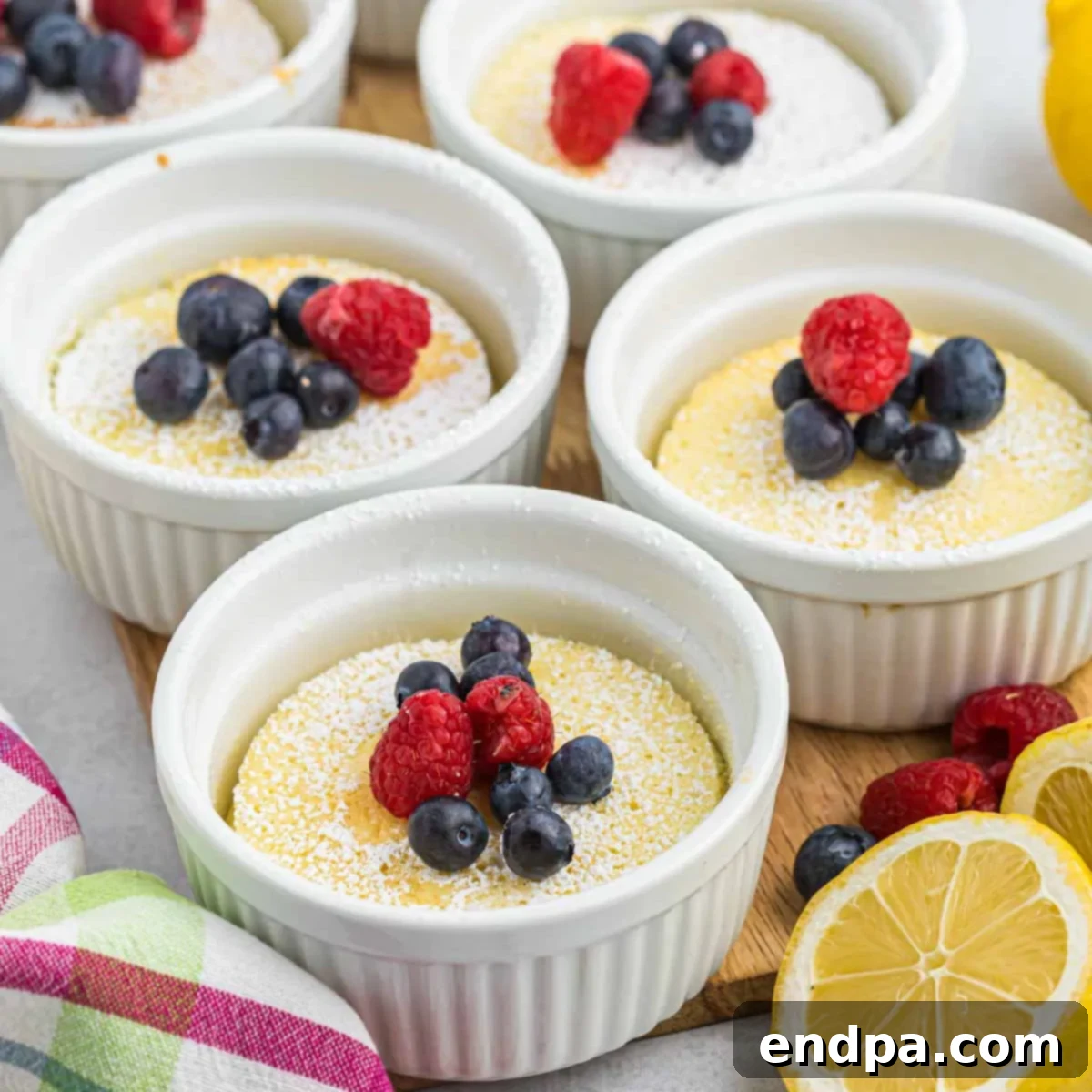Irresistible Lemon Pudding Cake: Your New Favorite Citrus Dessert
Prepare to be enchanted by the magic of Lemon Pudding Cake, a dessert that effortlessly combines sophistication with heartwarming comfort. Imagine a perfectly portioned treat, baked in individual ramekins, where each spoonful reveals a delightful surprise: a rich, velvety lemon pudding nestled beneath a tender, airy lemon cake. This isn’t just a dessert; it’s a culinary experience that promises a burst of bright, fresh citrus flavor, making it an absolute must-try for any lemon enthusiast.
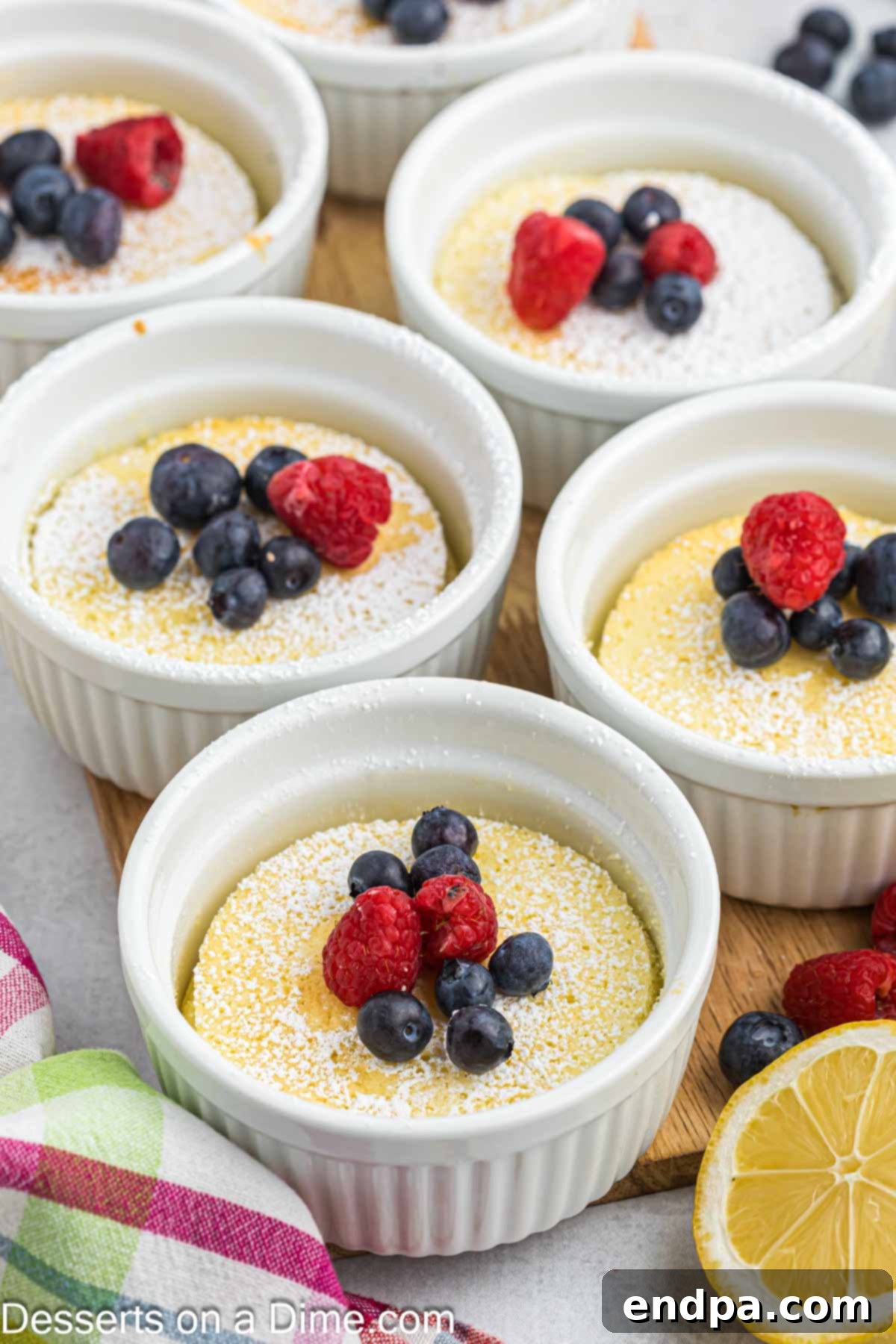
This Lemon Pudding Cake stands out as one of the Best Lemon Desserts you can make, offering unparalleled ease and an impressive presentation. Its individual servings make it a dream for entertaining, whether you’re hosting a dinner party, a brunch, or simply want to impress your family. The vibrant, fresh lemon flavor is universally loved, providing a refreshing counterpoint to richer meals. It’s also simple enough for even the busiest home cooks to whip up, making it a fantastic addition to any collection of Easy Summer Desserts or a thoughtful option among Mother’s Day Dessert Ideas. If you enjoy the bright notes of lemon, you might also love The Best Lemon Lush Dessert.
Table of Contents
- Why You’ll Adore This Lemon Pudding Cake Recipe
- The Magic Behind Lemon Pudding Cake: How it Works
- Essential Ingredients for the Perfect Lemon Pudding Cake
- Step-by-Step Guide to Crafting Your Lemon Pudding Cake
- Elevate Your Dessert: Delicious Topping Suggestions
- Storage and Preparation Tips for Lemon Pudding Cake
- Frequently Asked Questions (FAQs)
- More Zesty Lemon Desserts to Explore
Why You’ll Adore This Lemon Pudding Cake Recipe
- Simple, Wholesome Ingredients: You won’t need any exotic items for this recipe. It relies on everyday pantry staples, making it accessible and budget-friendly. This means fewer trips to the store and more time enjoying your delicious creation.
- Bursting with Fresh Lemon Flavor: The secret to this dessert’s captivating taste lies in the generous use of fresh lemon juice and zest. This dynamic duo infuses every layer with an authentic, bright, and invigorating citrus aroma that simply cannot be replicated with artificial flavors.
- Inexpensive to Make: Despite its gourmet appearance and exquisite taste, this pudding cake is remarkably economical. Using common ingredients keeps the cost down, proving that you don’t need to splurge to create an unforgettable dessert.
- Elegant Individual Portions: Baked in ramekins, these pudding cakes offer a sophisticated presentation that’s perfect for any gathering. Serving is a breeze, and each guest gets their own perfectly portioned, visually appealing dessert.
- Effortlessly Easy: Don’t let the dual texture fool you; this recipe is surprisingly straightforward. It’s an ideal choice for home bakers of all skill levels, delivering impressive results with minimal fuss.
- Versatile for Any Season: While often associated with spring and summer, the bright lemon flavor can be a refreshing treat year-round. It adds a touch of sunshine to any meal, no matter the season.
The Magic Behind Lemon Pudding Cake: How it Works
What makes a pudding cake so special? It’s the delightful culinary trick that happens during baking! You start with a single, seemingly uniform batter. However, as it bakes in a water bath, the magic unfolds. The lighter cake batter rises to the top, forming a fluffy, golden crust, while the denser, more liquid part of the batter settles beneath, transforming into a silky-smooth, tangy lemon pudding. This creates a two-layer dessert from a single pour, offering a delightful textural contrast that truly elevates the experience. It’s a testament to the beautiful chemistry of baking!
Essential Ingredients for the Perfect Lemon Pudding Cake
Creating this stunning lemon pudding cake starts with selecting the right ingredients. Each component plays a crucial role in achieving the desired texture and vibrant flavor.
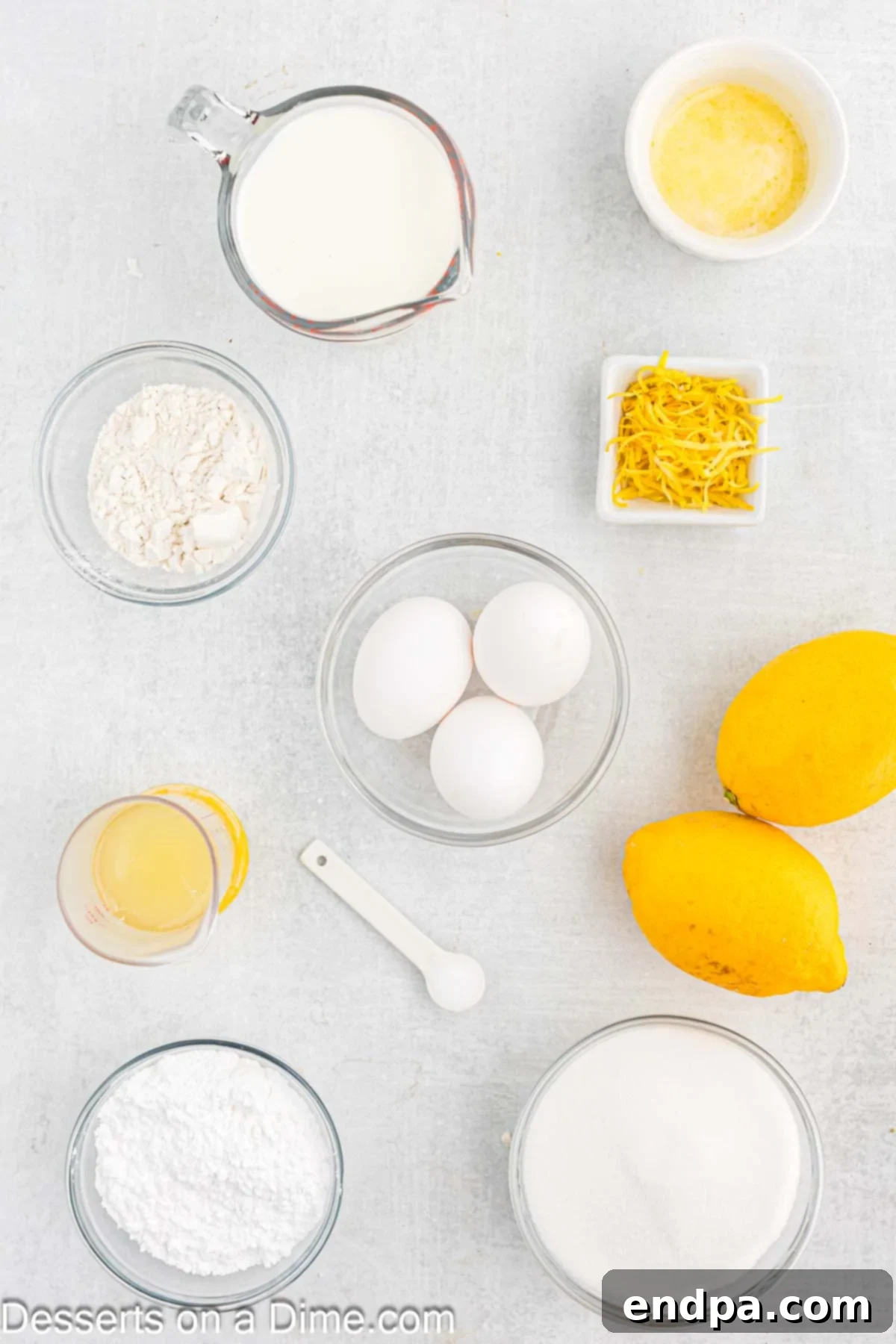
- Unsalted Butter: Always opt for unsalted butter when baking. This gives you complete control over the salt content in your recipe, ensuring a balanced flavor profile. Melting it beforehand helps it incorporate smoothly into the batter.
- Granulated Sugar: Beyond sweetness, sugar contributes to the cake’s tenderness and moistness. It also helps in achieving that beautiful golden-brown crust.
- Large Eggs (Room Temperature & Divided): Using room temperature eggs is vital as they emulsify better with other ingredients, resulting in a smoother, more uniform batter. Dividing the eggs into yolks and whites is key to the pudding cake’s unique texture; the yolks add richness to the pudding, while whipped egg whites provide the lift and lightness for the cake layer.
- All-Purpose Flour: The structural backbone of our cake. When measuring flour, spoon it lightly into your measuring cup and level it off with a straight edge. Scooping directly from the bag can compact the flour, leading to too much flour and a dry, dense cake.
- Whole Milk: The fat content in whole milk is essential for the richness and creamy texture of the pudding layer. Do not substitute with reduced-fat or skim milk, as this will compromise the final consistency and flavor.
- Fresh Lemon (Zested): Do not skip this step! Fresh lemon zest is packed with aromatic oils that provide an intense, bright lemon flavor far superior to any extract. Zest your lemon before juicing it for easier handling.
- Fresh Lemon Juice: Just like the zest, fresh lemon juice is non-negotiable for that authentic, tangy lemon punch. Bottled lemon juice often contains preservatives and lacks the vibrant taste of freshly squeezed.
- Salt: A pinch of salt is crucial in baking to balance the sweetness and enhance all the other flavors, particularly the lemon.
- Powdered Sugar: This is for a beautiful dusting on top of your finished cakes, adding a touch of elegance and a subtle extra sweetness.
The complete ingredient list with precise measurements can be found in the recipe card below.
Lemon Pudding Cake Recipe
This recipe yields 6 delightful servings, making it perfect for a small gathering or a decadent treat throughout the week.
Prep Time: 15 minutes
Cook Time: 40 minutes
Cooling Time: 15 minutes
Total Time: 1 hour 10 minutes
Cuisine: American
Course: Dessert
Calories: Approximately 251 kcal per serving
Author: Carrie Barnard
Ingredients
- 2 tablespoons unsalted butter, melted
- 1 cup granulated sugar
- 3 large eggs, at room temperature, separated (yolks and whites)
- 1/3 cup all-purpose flour
- 1 cup whole milk
- 1 large lemon, zested
- 1/3 cup fresh lemon juice
- 1/4 teaspoon salt
- Powdered sugar, for dusting (optional, for serving)
Step-by-Step Guide to Crafting Your Lemon Pudding Cake
Follow these detailed instructions to create your own individual lemon pudding cakes, mastering the delicate balance of cake and creamy pudding.
- Step 1: Prepare Your Oven and Ramekins. Preheat your oven to 350 degrees Fahrenheit (175°C). Lightly spray six 6-ounce ramekins with non-stick cooking spray. This crucial step ensures your delicate cakes won’t stick and can be easily removed, or served directly in their dishes.
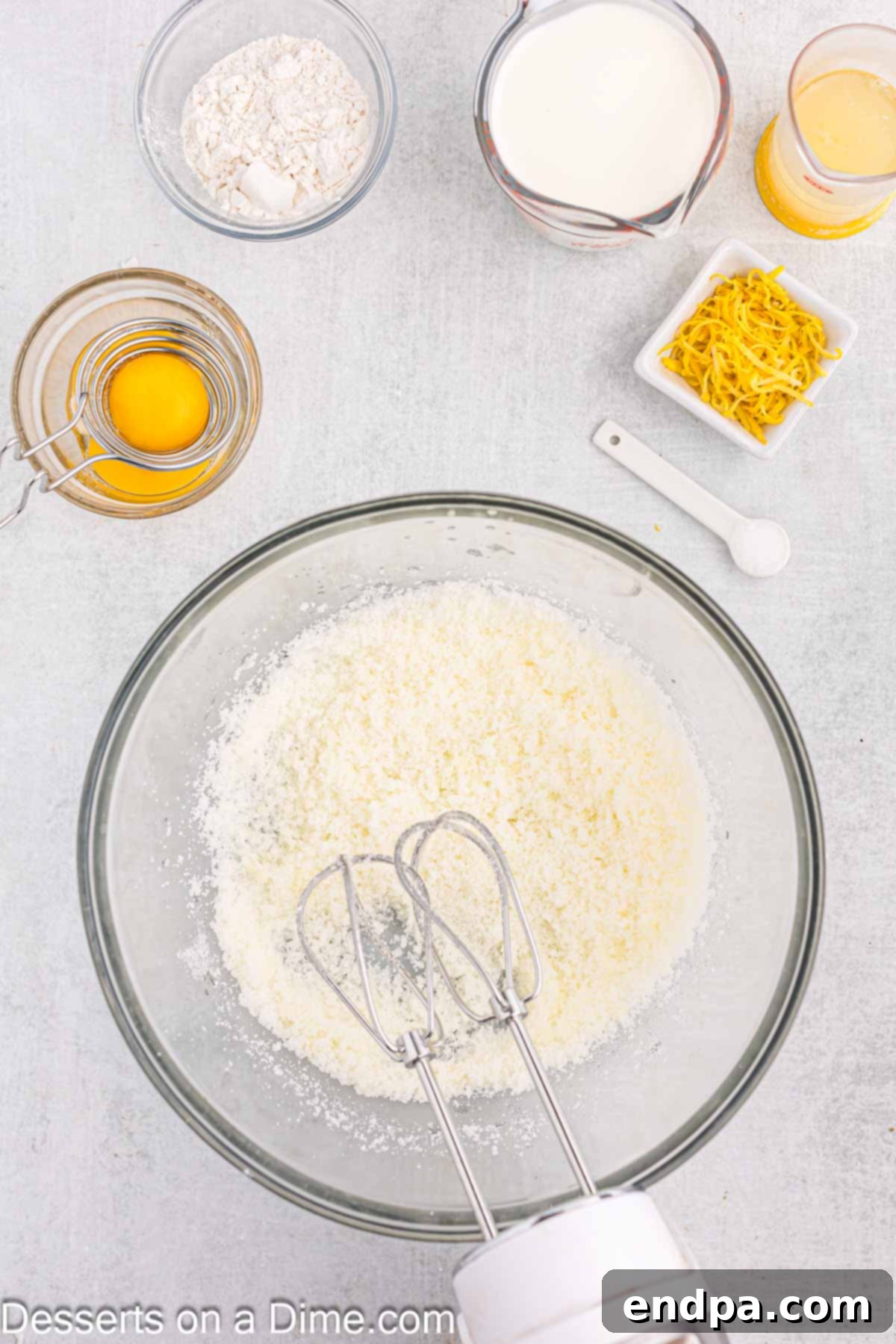
Step 2: Cream Butter and Sugar. In a large mixing bowl, combine the melted unsalted butter and granulated sugar. Using an electric mixer (or a whisk and some elbow grease), beat them together until the mixture is light, fluffy, and well combined. This process incorporates air, which is vital for the cake’s texture.
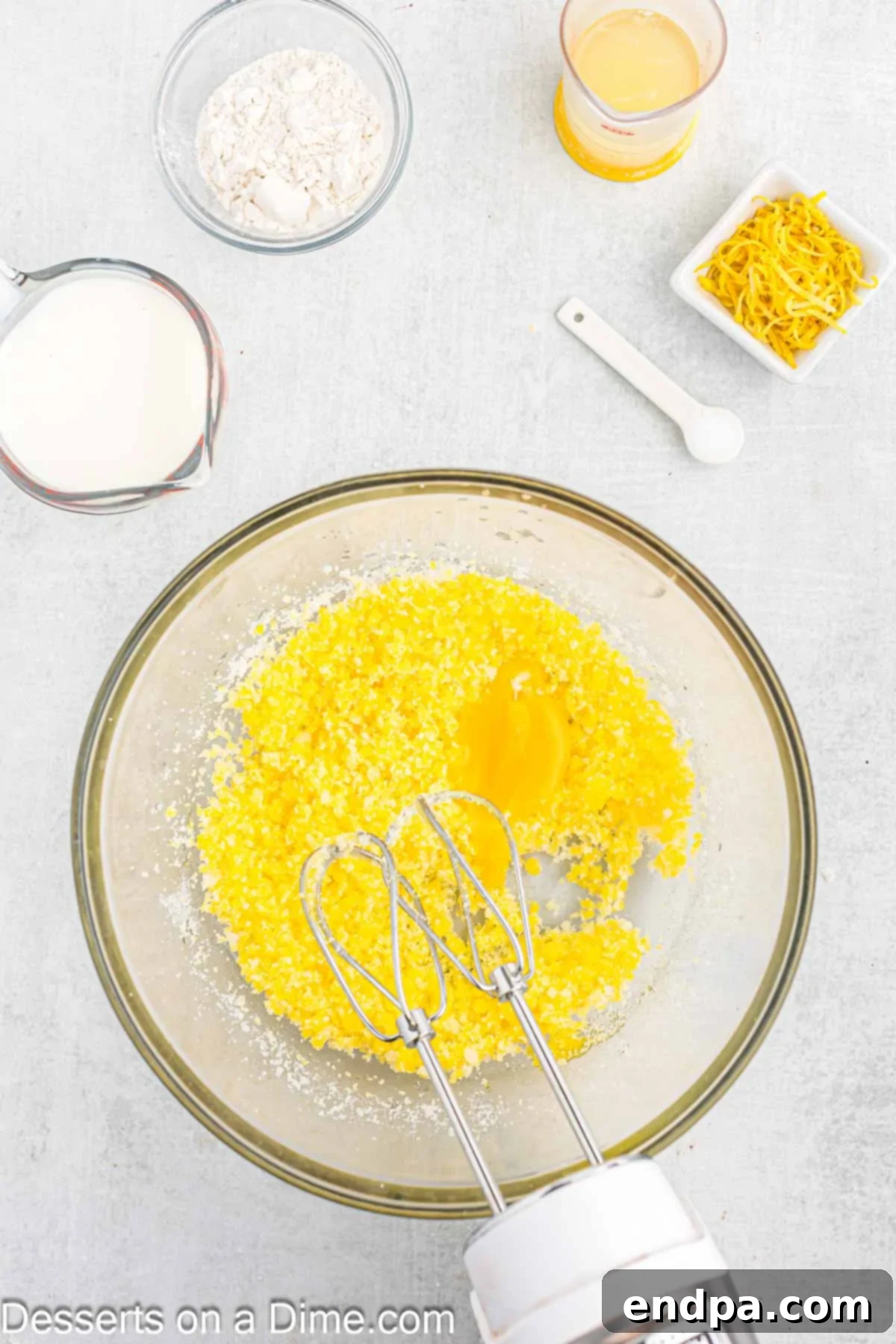
Step 3: Incorporate Egg Yolks. Add the egg yolks to the butter-sugar mixture one at a time, beating well after each addition. Ensure each yolk is fully incorporated before adding the next. This creates a richer, smoother base for the pudding layer.

Step 4: Add Wet and Dry Ingredients. Gradually mix in the whole milk, all-purpose flour, fresh lemon juice, and lemon zest into the bowl. Beat until the mixture is just combined and smooth. Be careful not to overmix the batter at this stage, as it can lead to a tough cake.
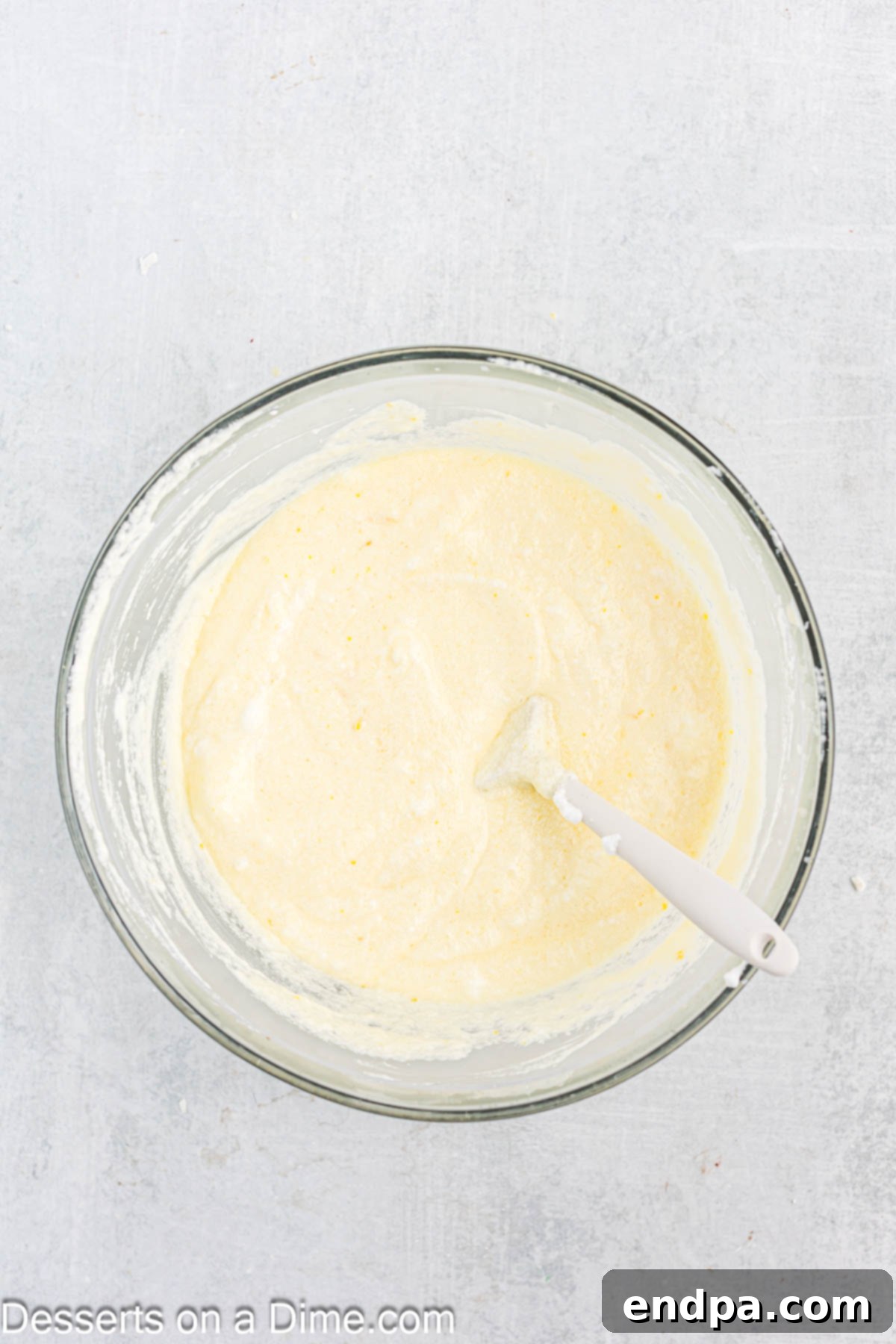
Step 5: Whip Egg Whites and Fold. In a separate, clean bowl, use an electric mixer to beat the reserved egg whites until they are fluffy and form soft peaks. These peaks should hold their shape but still be slightly pliable. Then, very gently fold the whipped egg whites into the lemon batter. This step is crucial for creating the light, airy cake layer that floats above the pudding.
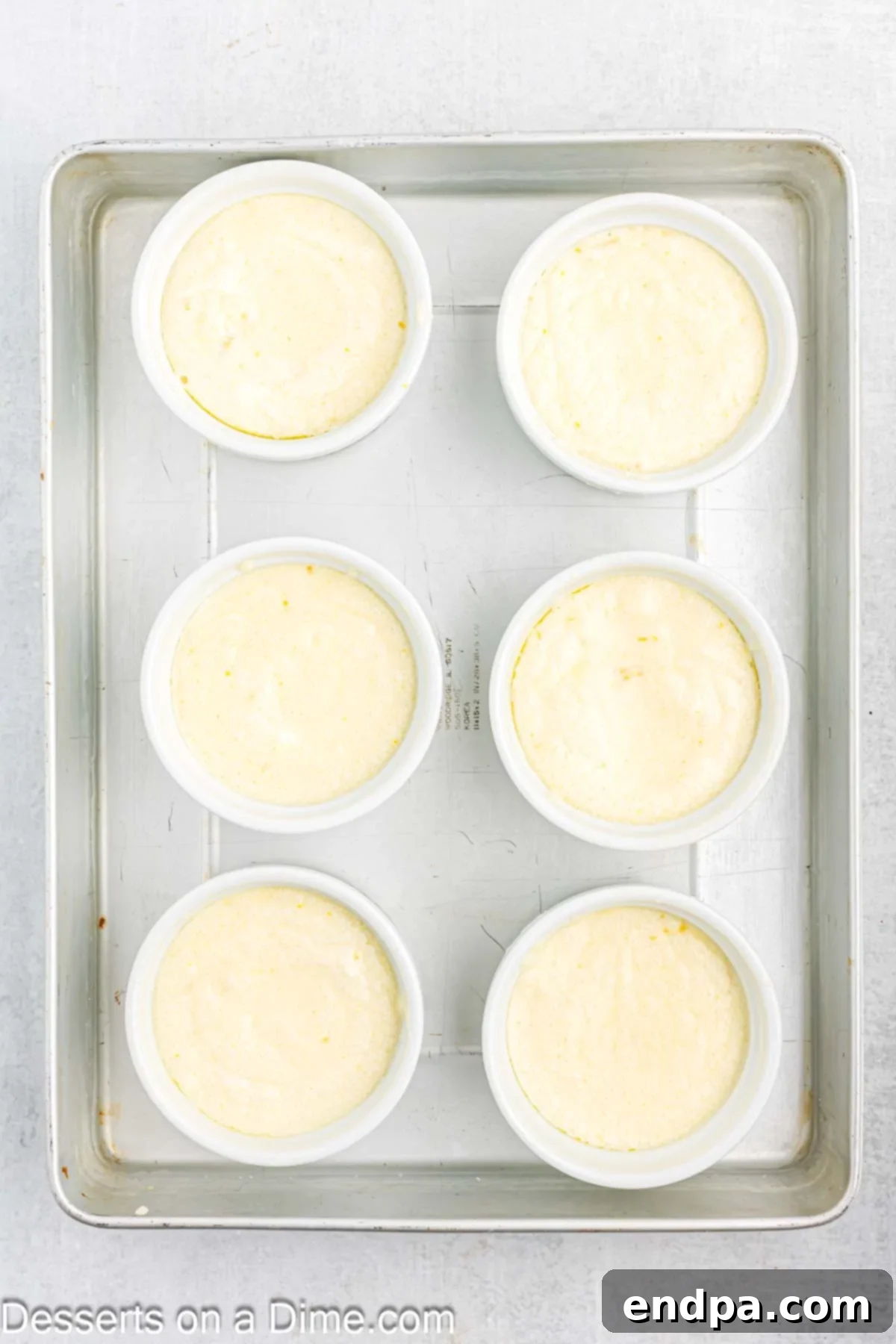
Step 6: Fill Ramekins and Prepare Water Bath. Carefully pour the batter evenly into your 6 prepared ramekins. Place these filled ramekins into a larger baking pan. Pour boiling water into the larger pan until it comes up approximately halfway (½) the sides of the ramekins. This water bath (bain-marie) is essential for even cooking and creating the distinct pudding layer.
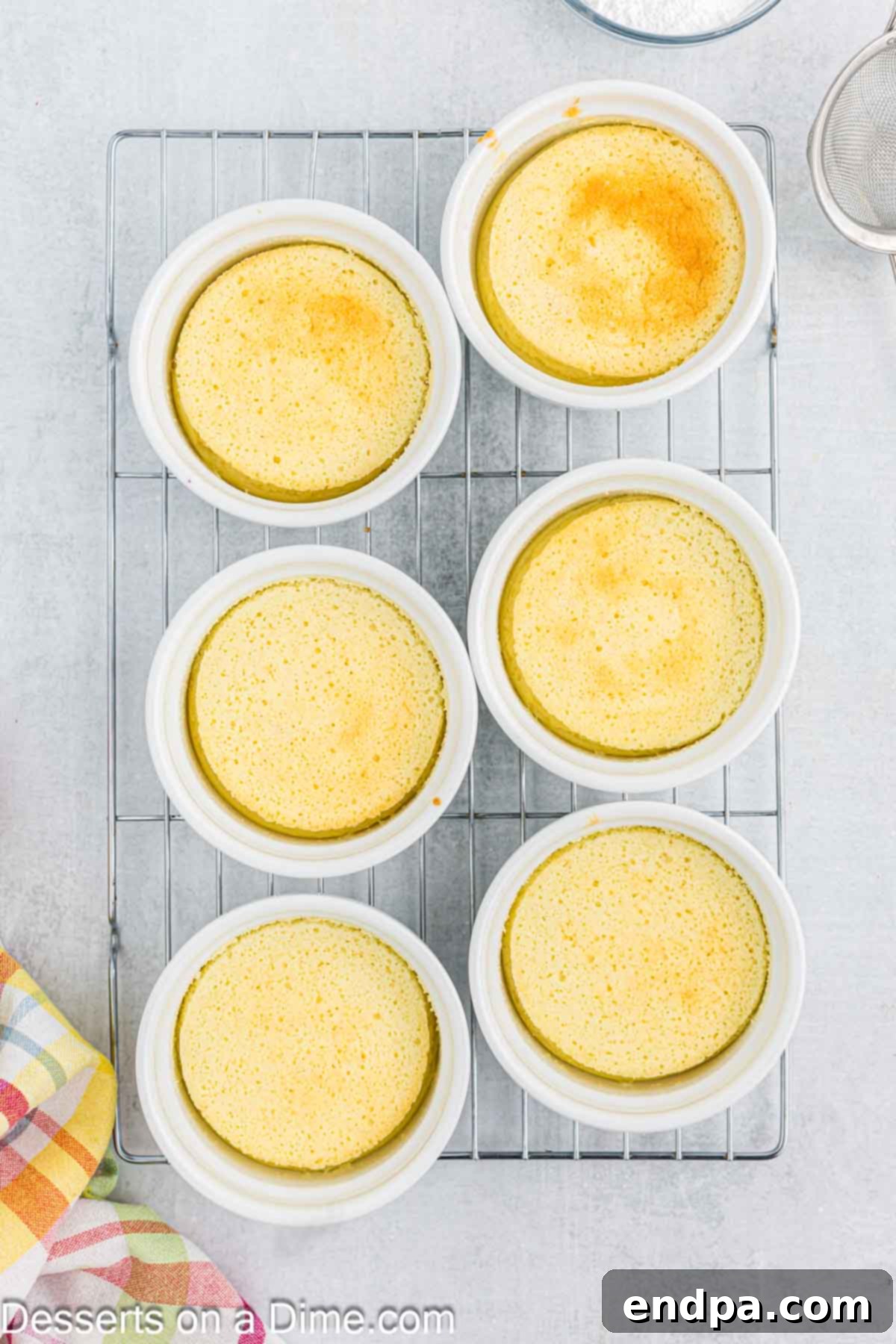
Step 7: Bake to Golden Perfection. Bake the cakes for 40-50 minutes. They are ready when the tops are beautifully golden brown and the center of the cake feels set. You can gently touch the center; it should spring back slightly. Overbaking will affect the pudding’s creamy texture. Once baked, carefully remove the ramekins from the water bath and place them on a wire rack to cool for 15-20 minutes before serving. This cooling time allows the pudding to set properly.
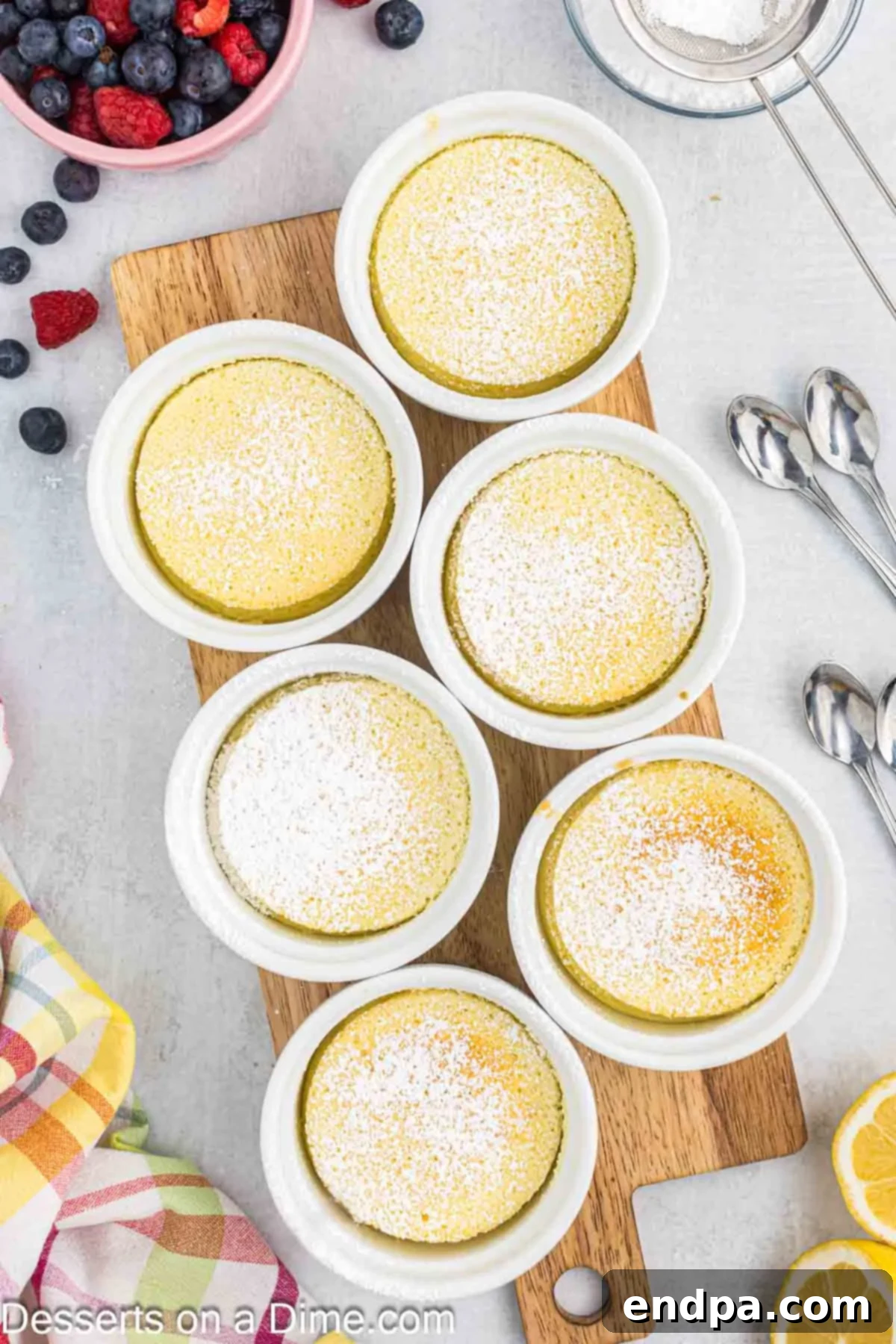
Step 8: Dust with Powdered Sugar. For an elegant finish and an extra touch of sweetness, lightly dust the cooled pudding cakes with powdered sugar using a fine-mesh sieve. This simple garnish makes them look even more inviting.
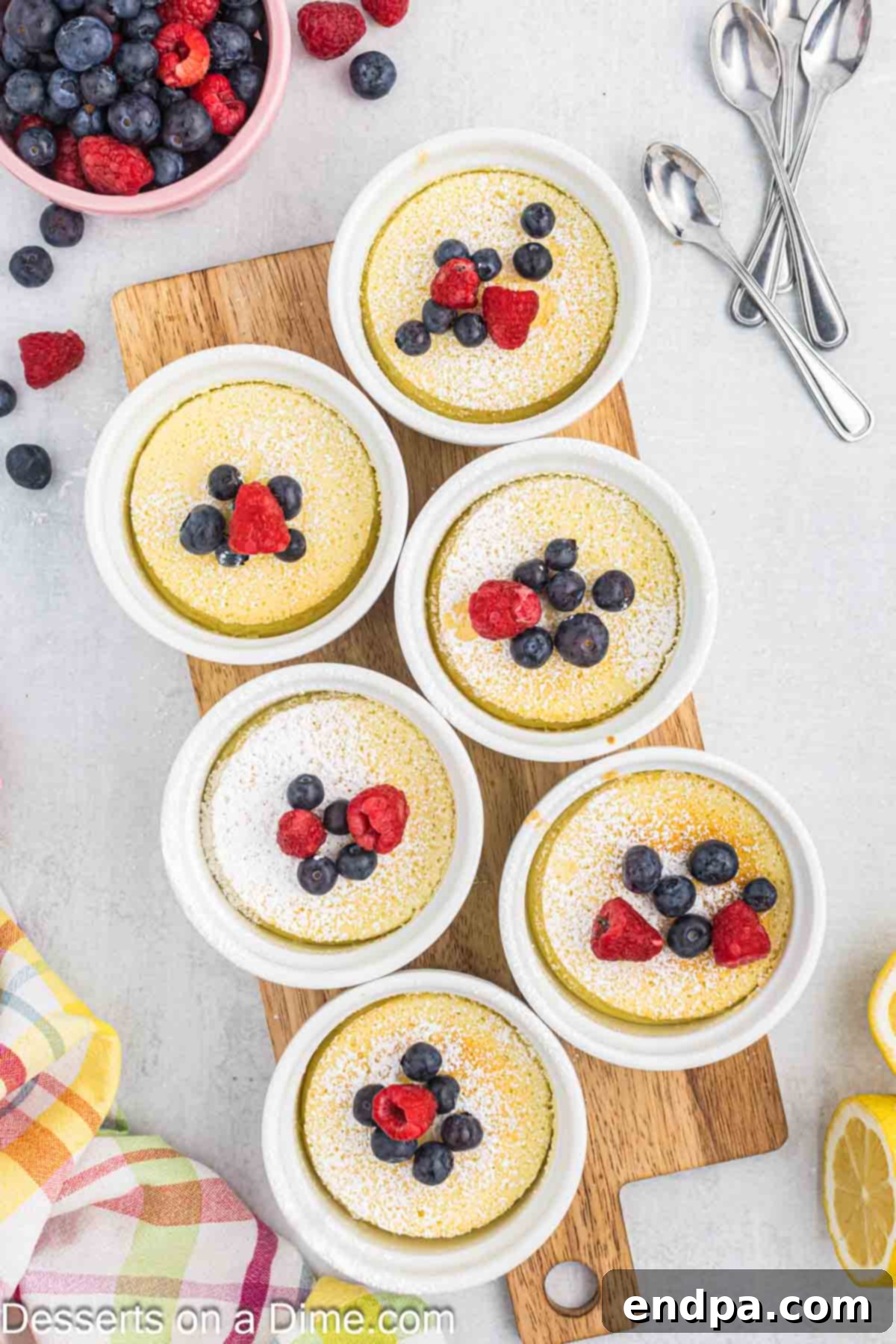
Step 9: Garnish and Serve. Serve your warm, delightful lemon pudding cakes with your favorite toppings. Fresh berries complement the lemon beautifully, adding color and a hint of tartness. Enjoy every zesty bite!
Elevate Your Dessert: Delicious Topping Suggestions
While delicious on its own, a simple topping can take your Lemon Pudding Cake from wonderful to truly spectacular. Here are a few ideas to inspire you:
- Fresh Fruit Medley: The bright tartness of fresh berries is a natural complement to lemon. Raspberries, strawberries, blueberries, or a mix of all three create a beautiful, flavorful garnish. A few slices of kiwi or a scattering of pomegranate seeds also work wonderfully.
- Homemade Whipped Cream: A dollop of fluffy Homemade Whipped Cream adds a luxurious creaminess that balances the lemon’s tang. You can sweeten it slightly with powdered sugar and a hint of vanilla or even a splash of lemon extract for extra zest. Store-bought whipped cream is also a quick and easy option.
- Simple Powdered Sugar: Sometimes, less is more. A light dusting of powdered sugar (confectioners’ sugar) provides a delicate sweetness and an elegant finish that lets the cake’s natural beauty shine through.
- Candied Lemon Peel: For a more gourmet touch, thinly sliced candied lemon peel offers a beautiful textural contrast and an intensified lemon flavor.
- Quick Lemon Glaze: Whisk together powdered sugar with a little fresh lemon juice to create a simple, tangy glaze. Drizzle it over the warm cakes for an extra layer of lemon flavor and a pretty sheen.
- Fresh Mint Sprigs: A small sprig of fresh mint adds a pop of vibrant green color and a refreshing aromatic note that enhances the overall experience.
Storage and Preparation Tips for Lemon Pudding Cake
To ensure your lemon pudding cakes remain as delicious as possible, follow these storage and expert tips:
Storage
Once cooled, you can wrap individual ramekins tightly with foil or plastic wrap and store them in the refrigerator for up to 3 days. To reheat, simply microwave them for a short time until warmed through. We do not recommend freezing this recipe, as the unique texture of the pudding layer can change significantly upon thawing.
Expert Tips for Success
- Don’t Overbake the Dessert: This is a critical tip for pudding cakes. The goal is a golden-brown top and edges that are set, but the pudding layer beneath needs to remain creamy. Overbaking will dry out the pudding, making it more like a dense cake. Keep a close eye on them during the last 10-15 minutes of baking. The center should gently spring back when lightly touched.
- You Can’t Make the Batter in Advance: The magic of this cake relies on the delicate structure of the folded egg whites. If the batter sits too long, the egg whites will deflate, resulting in a denser cake layer and less distinct separation between the cake and pudding. Prepare the batter just before you plan to bake.
- Room Temperature Ingredients are Key: This advice applies to many baking recipes, but it’s especially important here. Room temperature butter, milk, and eggs combine more easily and smoothly, creating a homogeneous batter. Cold ingredients can cause the batter to curdle or become lumpy. Furthermore, room temperature egg whites whip up to a much greater volume, which is essential for that light, fluffy cake topping.
- Proper Zesting and Juicing: For maximum flavor, use a microplane grater to zest only the bright yellow part of the lemon, avoiding the bitter white pith. For juicing, roll the lemon firmly on your counter before cutting it in half; this helps release more juice.
- The Importance of the Water Bath: The water bath (bain-marie) creates a moist, gentle cooking environment that helps the pudding layer set slowly and evenly without curdling. It also insulates the bottom of the ramekins, ensuring the pudding remains custardy while the top bakes into a cake.
Frequently Asked Questions (FAQs)
Can I use a different size pan?
Yes, you can certainly make this recipe in a single large baking dish instead of individual ramekins. An 8×8 square baking dish is a good alternative. However, be aware that the baking time will need to be adjusted; a larger dish will require a longer baking period. Start checking for doneness around 50-60 minutes and continue baking until the top is golden and the center is set.
Why does the recipe call for a water bath?
The water bath is a crucial technique for this recipe. It serves two primary purposes: firstly, it helps to prevent the delicate pudding layer from overcooking and becoming rubbery or dry. The gentle, moist heat ensures a silky-smooth, custardy texture. Secondly, it plays a vital role in allowing the lighter cake portion of the batter to rise beautifully over the pudding layer, creating that distinctive two-layer effect.
Can I freeze this recipe?
Unfortunately, we do not recommend freezing this pudding cake. The unique texture, particularly the creamy pudding layer, tends to change when frozen and thawed. It can become grainy or separate, losing its delightful consistency. This dessert is best enjoyed fresh or stored in the refrigerator for a few days.
Can I use bottled lemon juice?
While you technically could, we strongly advise against using bottled lemon juice for this recipe. The fresh lemon zest and juice are the stars, providing a bright, vibrant, and authentic citrus flavor that cannot be replicated by pre-packaged alternatives. Bottled juices often contain preservatives and lack the nuanced aroma and tartness of fresh lemons, which would significantly diminish the taste of your pudding cake.
How do I know when my lemon pudding cake is perfectly baked?
Look for a beautiful golden-brown top on your cakes. The edges should appear set and firm. The best test is to gently tap or lightly press the center of the cake with your fingertip; it should spring back slightly. If it feels too jiggly or liquid, it needs a few more minutes. Conversely, if it feels too firm, it might be overbaked.
More Zesty Lemon Desserts to Explore
If you’re a fan of the bright, refreshing taste of lemon, you’re in for a treat! Explore these other fantastic lemon dessert recipes that are sure to satisfy your citrus cravings.
Cookies
Lemon Cake Mix Cookies
Cakes
Lemon Cheesecake Bars Recipe
Easy Cupcake
Lemon Cupcakes
Cakes
Lemon Icebox Cake
Your Culinary Adventure Awaits!
We hope this comprehensive guide inspires you to create your very own Lemon Pudding Cakes. This delightful dessert truly offers the best of both worlds – a light, fluffy cake and a rich, creamy pudding, all infused with the invigorating zest of fresh lemons. It’s a perfect treat for brightening any day or celebrating a special moment.
Don’t just take our word for it; try this easy recipe and experience the magic yourself. We’d love to hear about your baking success and see your beautiful creations. Once you do, please come back and leave a comment with your star rating. Happy baking!

Want to save this recipe for later? Pin it to your favorite dessert board on Pinterest!
Pin Recipe Now
Nutrition Facts (Per Serving)
Calories: 251 kcal, Carbohydrates: 43g, Protein: 5g, Fat: 7g, Saturated Fat: 4g, Polyunsaturated Fat: 1g, Monounsaturated Fat: 2g, Trans Fat: 0.2g, Cholesterol: 97mg, Sodium: 145mg, Potassium: 139mg, Fiber: 1g, Sugar: 36g, Vitamin A: 306IU, Vitamin C: 15mg, Calcium: 70mg, Iron: 1mg
